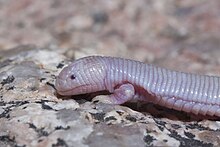Bipes (lizard): Difference between revisions
Appearance
Content deleted Content added
m →Further reading: Remove blank line(s) between list items per WP:LISTGAP to fix an accessibility issue for users of screen readers. Do WP:GENFIXES and cleanup if needed. Discuss this at Wikipedia talk:WikiProject Accessibility#LISTGAP |
Cyberbot II (talk | contribs) Rescuing 1 sources. #IABot |
||
| Line 27: | Line 27: | ||
== External links == |
== External links == |
||
* http://www.jcvi.org/reptiles/families/bipedidae.php |
* http://web.archive.org/web/20090514074919/http://www.jcvi.org:80/reptiles/families/bipedidae.php |
||
[[Category:Amphisbaenians]] |
[[Category:Amphisbaenians]] |
||
Revision as of 03:54, 21 March 2016
| Bipes | |
|---|---|

| |
| Bipes biporus | |
| Scientific classification | |
| Domain: | Eukaryota |
| Kingdom: | Animalia |
| Phylum: | Chordata |
| Class: | Reptilia |
| Order: | Squamata |
| Clade: | Amphisbaenia |
| Family: | Bipedidae |
| Genus: | Bipes Latreille, 1801 |
| Species | |
|
Bipes alvarezi [1] | |
Bipes is a genus of amphisbaenians found only in Mexico, the sole living member of the family Bipedidae.[3] Commonly known as ajolotes, they are carnivorous, burrowing reptiles, but unlike other species of amphisbaenians, they possess two stubby forelimbs placed far forward on the body.[4] The shovel-like limbs are used to scrape away soil while burrowing through the soil, in a manner similar to a mole.[5] Evidence for their occurrence in the United States is reviewed by Somma (1993).
References
- ^ Wikispecies. species.wikimedia.org/wiki/Bipes.
- ^ ITIS (Integrated Taxonomic Information System). www.itis.gov.
- ^ Longrich, N. R.; Vinther, J.; Pyron, R. A.; Pisani, D.; Gauthier, J. A. (2015). "Biogeography of worm lizards (Amphisbaenia) driven by end-Cretaceous mass extinction". Proceedings of the Royal Society B: Biological Sciences. 282 (1806): 20143034. doi:10.1098/rspb.2014.3034.
- ^ http://www.whatamidoingonline.com/2012/09/21/10-amazing-creatures-find-adventuring/
- ^ Gans, Carl (1998). Cogger, H.G., & Zweifel, R.G. (ed.). Encyclopedia of Reptiles and Amphibians. San Diego: Academic Press. pp. 216–217. ISBN 0-12-178560-2.
{{cite book}}: CS1 maint: multiple names: editors list (link)
Further reading
- Latreille, P.A. in Sonnini, C.S., and P.A. Latreiile. 1801. Histoire naturelle des reptiles, avec figures desinées d'après nature; Tome II. Premiere partie. Quadrupèdes et bipèdes ovipares. Crapalet. Paris. 332 pp. (Bipes, pp. 90–96.)
- Taylor, E.H. 1951. Concerning Oligocene Amphisbaenid Reptiles. Univ. Kansas Sci. Bull. 34 (9): 521-579. (Bipedidae, p. 522.)
- Louis A. Somma, "Do Worm Lizards Occur in Nebraska?" "Nebraska Herpetological Newsletter 12:2 (1993), 1-10
External links
